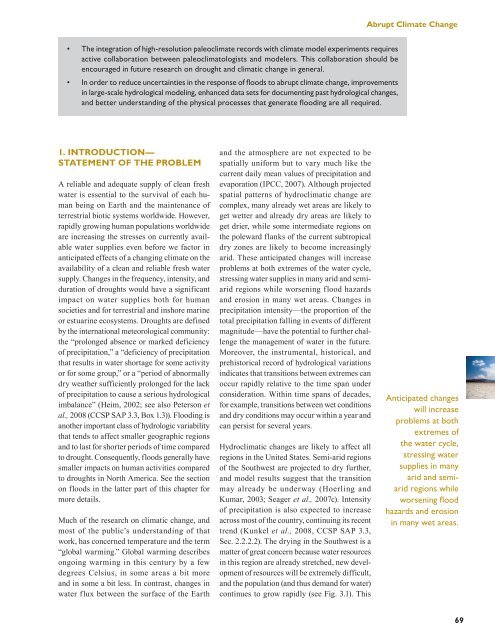Book 2.indb - US Climate Change Science Program
Book 2.indb - US Climate Change Science Program
Book 2.indb - US Climate Change Science Program
- No tags were found...
You also want an ePaper? Increase the reach of your titles
YUMPU automatically turns print PDFs into web optimized ePapers that Google loves.
Abrupt <strong>Climate</strong> <strong>Change</strong>• The integration of high-resolution paleoclimate records with climate model experiments requiresactive collaboration between paleoclimatologists and modelers. This collaboration should beencouraged in future research on drought and climatic change in general.• In order to reduce uncertainties in the response of floods to abrupt climate change, improvementsin large-scale hydrological modeling, enhanced data sets for documenting past hydrological changes,and better understanding of the physical processes that generate flooding are all required.1. Introduction—Statement of the ProblemA reliable and adequate supply of clean freshwater is essential to the survival of each humanbeing on Earth and the maintenance ofterrestrial biotic systems worldwide. However,rapidly growing human populations worldwideare increasing the stresses on currently availablewater supplies even before we factor inanticipated effects of a changing climate on theavailability of a clean and reliable fresh watersupply. <strong>Change</strong>s in the frequency, intensity, andduration of droughts would have a significantimpact on water supplies both for humansocieties and for terrestrial and inshore marineor estuarine ecosystems. Droughts are definedby the international meteorological community:the “prolonged absence or marked deficiencyof precipitation,” a “deficiency of precipitationthat results in water shortage for some activityor for some group,” or a “period of abnormallydry weather sufficiently prolonged for the lackof precipitation to cause a serious hydrologicalimbalance” (Heim, 2002; see also Peterson etal., 2008 (CCSP SAP 3.3, Box 1.3)). Flooding isanother important class of hydrologic variabilitythat tends to affect smaller geographic regionsand to last for shorter periods of time comparedto drought. Consequently, floods generally havesmaller impacts on human activities comparedto droughts in North America. See the sectionon floods in the latter part of this chapter formore details.Much of the research on climatic change, andmost of the public’s understanding of thatwork, has concerned temperature and the term“global warming.” Global warming describesongoing warming in this century by a fewdegrees Celsius, in some areas a bit moreand in some a bit less. In contrast, changes inwater flux between the surface of the Earthand the atmosphere are not expected to bespatially uniform but to vary much like thecurrent daily mean values of precipitation andevaporation (IPCC, 2007). Although projectedspatial patterns of hydroclimatic change arecomplex, many already wet areas are likely toget wetter and already dry areas are likely toget drier, while some intermediate regions onthe poleward flanks of the current subtropicaldry zones are likely to become increasinglyarid. These anticipated changes will increaseproblems at both extremes of the water cycle,stressing water supplies in many arid and semiaridregions while worsening flood hazardsand erosion in many wet areas. <strong>Change</strong>s inprecipitation intensity—the proportion of thetotal precipitation falling in events of differentmagnitude—have the potential to further challengethe management of water in the future.Moreover, the instrumental, historical, andprehistorical record of hydrological variationsindicates that transitions between extremes canoccur rapidly relative to the time span underconsideration. Within time spans of decades,for example, transitions between wet conditionsand dry conditions may occur within a year andcan persist for several years.Hydroclimatic changes are likely to affect allregions in the United States. Semi-arid regionsof the Southwest are projected to dry further,and model results suggest that the transitionmay already be underway (Hoerling andKumar, 2003; Seager et al., 2007c). Intensityof precipitation is also expected to increaseacross most of the country, continuing its recenttrend (Kunkel et al., 2008, CCSP SAP 3.3,Sec. 2.2.2.2). The drying in the Southwest is amatter of great concern because water resourcesin this region are already stretched, new developmentof resources will be extremely difficult,and the population (and thus demand for water)continues to grow rapidly (see Fig. 3.1). ThisAnticipated changeswill increaseproblems at bothextremes ofthe water cycle,stressing watersupplies in manyarid and semiaridregions whileworsening floodhazards and erosionin many wet areas.69






